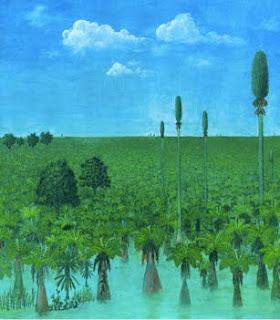 |
| Reconstruction of Permian Forest from Inner Mongolia (Jun Wang et al. 2012) |
OK I'm back after a long hiatus due to extensive travel (yay) and work (boo) commitments. There have been a few things to cover over the next few weeks, but in the meantime, something a little, . . . umm . . . younger than we're used to here on Ediacaran - but there is a link.
Working out how fossil organisms interacted is very difficult as they are usually found singularly or in small groups. Certain things, such as predation for example, can be worked out using single of small groups of fossils, but community interactions require large scale preservation. Such ecological-scale preservation is rare, but some do exist, for example Cretaceous dinosaur footprints, and Devonian fish. A new find from China has added to this small list.
In the earliest part of the Permian, around 298 million years ago, a large volcanic eruption in what is now northern China, resulted in a swampy region being covered by an approximately 100cm thick volcanic tuff. Just like in the more famous example of Pompeii, the tuff trapped and preserved everything beneath it. The ash fall buried and choked the plants, braking off twigs and leaves, felling trees, and preserved the forest remains in place.
Now part of a coal field 8km west of Wuda, Inner Mongolia, the Taiyuan Formation has revealed a wealth of exceptional preservation, but also a wealth of ecological information. The site has allowed approx. 1000 square meters of Permian swamp to be uncovered and systematically investigated. It has allowed the reconstruction of Permian plants, and has also provided information on the relationships between the plants growing at the time.
At the site, six groups of plants make up the vegetation, and an examination of the relationships shows several areas of distinctly different plant occurrences, as well as a number of patterns of co-occurrence. These allow for detailed reconstructions of the original forest, one of which is the photo at the start of this entry.
Some of the exceptional preservation is shown below.
So, what has this Permian deposit to do with the Ediacaran?
Well, this ecologically-focussed investigation has also been undertaken for the Ediacaran fauna. There are a couple of examples of such eco-related investigations.
The first is from the Ediacaran of Newfoundland. At Mistaken Point, the beds outcropping along the coast dip at shallow angles, which means that tennis court-sized areas of old sea floor are exposed along the cliff. Abundant Ediacaran fossils have been found on these surfaces . These fossils include spindle forms as well as the more familiar Charnodiscus disc-shaped forms. The relatively large expanse of uncovered old sea floor allows some interrelationships to be looked at.
Interestingly (and in another link to the Permian find above), preservation here is different to that in South Australia. Here, fossils are found on the top surface of the bed. This is because the organisms and sea floor was covered by an ash falls from volcanic eruptions some time around 565 million years ago. As in the Permian example, ash covered everything and subsequently preserved a snapshot of life at the time.
 |
| Ediacaran fossils from Mistaken Point, and the ash layer which has preserved them (photo credit) |
The second example comes from South Australia. In the Flinders Ranges, several Ediacaran locations occur in low-lying hills with gentle slopes. As the beds erode out of the soil, they move down slope. As the area is remote, there is little disturbance, and so it is possible to roam the slope picking up pieces of distinctive layers and reconstructing the Ediacaran sea floor.
 |
| Reconstructing Ediacaran sea floors from South Australia, both in the field, and at the South Australian Museum (photo credit 1, 2) |
The difference here is that the fossils are found on the underside of the bed, not on the top surface, which is normally contains ripple marks caused by current and wave action (as seen in the photo from the South Australian Museum above).
The ability to look at whole communities, rather than individuals provides a much better understanding of what was going on in the past which makes sites where you can actually do that very important.
Jun Wang, Hermann W. Pfefferkorn, Yi Zhangc, and Zhuo Feng. (2012) Permian vegetational Pompeii from Inner Mongolia and its implications for landscape paleoecology and paleobiogeography of Cathaysia. Proceedings of the National Academy of Science of the United States of America, Published online before print, doi: 10.1073/pnas.1115076109

